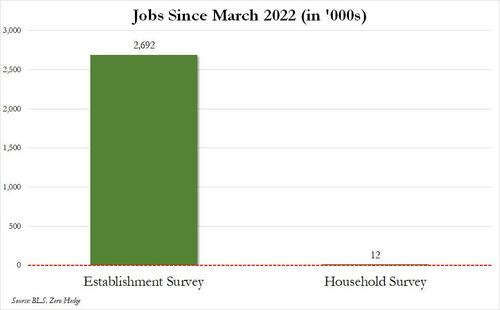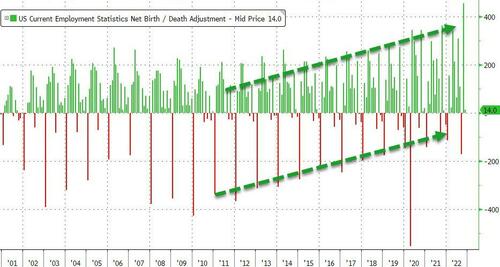Government Jobs Numbers Don’t Add Up

Have you ever had a gut feeling that the labor reports put out by the Bureau of Labor Statistics are hinky?
If so, trust your gut.
Based on the headline numbers we got in the November Non-Farm Payroll report, the labor market is strong. The economy added 263,000 jobs last month, well above the 200,000-job projection. The unemployment rate remained flat at a historically low 3.7%.
Based on this labor report, the mainstream declared the labor market is “resilient.” Stocks and gold immediately sold off as investors assumed another solid jobs report means the Fed can continue to take an aggressive approach in its “war” on inflation. The Biden administration bragged about how it’s creating jobs.
But you don’t have to dig very far into these government numbers to realize they just don’t add up.
The BLS monthly jobs report is actually based on two surveys – the Household Survey and the Establishment Survey. The headline number of “jobs created” comes from the Establishment Survey. That’s what the media reports. But the Household Survey tells a completely different story.
While the Establishment survey has shown a healthy rise in new jobs every single month, the Household Survey shows job growth has been stagnant. In fact, based on the Household Survey, the number of employed people actually dropped by 138,000 people.
In fact, based on the Household Survey, employment has been flat since March with virtually no jobs added.
According to the Establishment Survey, the economy has added 2.69 million jobs since March. That’s the sum of all those headline numbers you’ve been hearing. But based on the Household Survey, there were only 12,000 more employed people in November than there were in March.
Here’s what this chart is telling you. As of March, there were 158.458 million employed workers. Last month, there were 158.470 million employed workers. The increase in employed workers was only 12,000 over that 8-month period. Meanwhile, the number of payrolls reportedly increased by 2.7 million.
How do you explain this divergence?
Part of it is due to the way each survey counts a job. The Household Survey counts employed people. If you have two jobs, you’re still just counted as one employed person in that survey. But if you are working full-time and go out and get a part-time job in order to make ends meet, the Establishment Survey will count that as a “new” job. One person with two jobs counts as two jobs in the Establishment Survey.
In other words, a lot of the “new” jobs in the Establishment Survey are people getting second or even third jobs trying to stay ahead of rapidly rising prices.
Based on the Household Survey, the US economy has lost 398,000 full-time workers since March. That was offset by a gain of 190,000 part-time workers. Meanwhile, the number of people working two jobs rose by 291,000 workers since March.
Another factor juicing the number of “new jobs” is the Establishment Survey does not count unincorporated self-employed workers. As small businesses shut down and workers shift into corporate jobs, the Establishment Survey records them as “new” jobs even though the worker has only shifted from uncounted self-employed work to counted corporate work. As an article on Fox News explained, “There is no change in the number of people employed, but the headline jobs number actually increases because the person merely shifts from an uncounted category to one which is counted.”
According to Fox News analysis, double-counting in November accounted for about 454,000 jobs.
It also explains the entire monthly divergence between the two surveys, which was 401,000. It turns out the economy might not have been employing any new people at all in November.”
As an article at ZeroHedge pointed out, the BLS uses a lot of tricks to manipulate the numbers. For instance, it factors in “birth-death” adjustments, which are really nothing but wild guesses. These “birth-death” adjustments hit a record high of 455,000 in October.
The trend in speculative BLS assumptions about the viability of the US economy (more businesses are created than are shut down only when there is economic solid growth) is clearly visible in the chart below.”
In other words, the people over at the BLS are making assumptions that skew the employment numbers to the upside.
The following statement from a friend who closely follows economic data summed it up perfectly.
All these numbers are estimates based on phone surveys. In other words, it’s all BS models. There is no mechanism that BLS could access to actually know how many jobs were created or new employment. Employers don’t report anything that would allow this to be known. They report this s**t every month and people believe it likes it’s temperature measurement. It is 100% made up BS. Like they literally just make it up. It’s whatever ‘they’ want it to be.”
Interestingly, ZeroHedge points out that we saw similar large divergences between the two surveys right before the second Obama election and prior to Hillary Clinton challenging Donald Trump in 2020.
Here’s how ZeroHedge summed it up.
So, what’s going on here? The simple answer: as shocking as this may sound, there has been no change in the number of people actually employed in the past 8 months, but due to deterioration in the economy, more people are losing their higher-paying, full-time jobs, and switching into much lower- paying, benefits-free part-time jobs, which also forces many to work more than one job, a rotation which picked up in earnest some time in March and which has only been captured by the Household survey. Meanwhile, the Establishment survey plows on ahead with its politically-motivated approximations, seasonal adjustments, and other labor market goal-seeking meant to make the Biden admin look good and provide the Fed with ammo to keep rates high (thus forcing even more real layoffs, which unfortunately the BLS is incapable of capturing due to political reasons).”
My advice — if nothing else, take these government employment numbers with a grain of salt.
Get Peter Schiff’s most important gold headlines once per week – click here – for a free subscription to his exclusive weekly email updates.
Interested in learning how to buy gold and buy silver?
Call 1-888-GOLD-160 and speak with a Precious Metals Specialist today!
Buka akaun dagangan patuh syariah anda di Weltrade.
Source link









